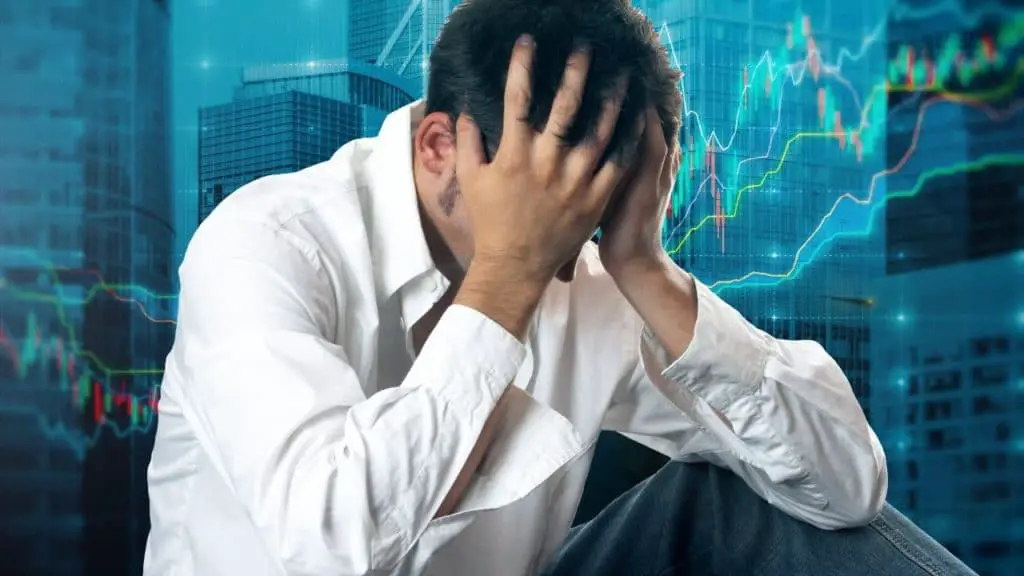The main reason for the trader’s losses is his own actions. And the price a trader pays his emotions is much higher than any other mistake. This article is about fighting emotions in cryptocurrency trading.
Traders who make a mistake when entering a transaction or taking profits suffer a loss on this transaction, and can compensate for it with profit in the next one. Traders who fall under the power of greed or fear, as a rule, lose their entire deposit and leave the market.
Emotions in trading and struggle with them
In the financial markets, the crowd never makes money – it serves as fuel for market movements and is doomed to give money to the minority.
The cryptocurrency market is young and wild, and the chance of losing money on it is much higher than on any others. But no other market offers the opportunity to increase your deposit.
The most important thing for a trader to master is not technical and fundamental analysis, and not even comprehend the logic of the actions of large players, but to figure out his own brain. After all, it’s not the manipulators, insiders and whales that make the trader buy at the highs after a week of asset growth, sell at the bottom, open a position on the entire deposit and lose his money after that. He does this under the influence of his vices – pride (the desire to always be right), stupidity (lack of knowledge and unwillingness to assimilate them) and greed.
In addition to vices, emotions play a no less negative role. On August 21-22, the “fear index” fell to 5. This is an absolute minimum, there were no such values even in the most difficult periods of cryptozyme. In this case, objectively, there is no negative – just Bitcoin could not break 11,000 and fell just below 10,000. Moreover, this situation has been three times in the last month. There was no logical justification for such fear; the picture was completely ordinary. Nevertheless, the crowd was paralyzed by fear, which forces many market participants to sell their assets in a situation where this is contrary to logic and common sense.
On August 23, the fear index again in the flat zone rose to 33. At the same time, the price rose by $ 200, which is a bit more for bitcoin than nothing. Fear had no rational explanations the day before. But this did not stop many market participants from giving their assets at ridiculous prices. And they should only thank their emotions for this. FOMO is also based on emotions, when traders buy an asset at the peak, after a long recoilless growth.
When a position is held and built up against the trend until the drain, not wanting to admit the obvious, or when after a series of successful transactions the trader increases the position several times without increasing the size of the deposit, he does all this under the influence of emotions.
In all of these examples, the trader will lose money. If he does this often (and a trader who is dependent on emotions does just that), he will soon find himself in a situation of “stop trading, otherwise there is nothing to give change to.”
A trader can understand when to buy and sell an asset, analyze the market situation and draw the right conclusions. But when emotions turn on, the brain turns off. By the way, this applies not only to trading, but to any situation where you need to make quick and correct decisions. It turns out that the main obstacle to success in trading is the trader himself. Rather, his market decisions and actions that he performs, guided by emotions, and not reason.
How to deal with this?
First of all, the problem must be identified. The following are typical situations in which practical actions manifest various emotions on the market. If you do not find anything similar to your actions, then you are a terminator and the problem of emotions is not before you. Or you can be congratulated on the fact that you have already successfully resolved these problems.
Situation number 1
You see that the asset grew by 20-30-50% without you. There is no objective reason to believe that growth will continue, and you understand that. Nevertheless, the thought “what if it grows again, I already missed how much” is so unbearable for you that you buy this asset. After a few days (or hours), you understand that you bought it at the peak, and it was a very bad entrance.
IMPORTANT MOMENT. This is not a mistake in assessing the situation (for example, you think that this is the beginning of a trend and further growth is inevitable). You buy only because the desire to buy is stronger than you.
And such situations are repeated repeatedly.
Situation number 2
You bought an asset, a position in good profit (say, 50%). You have no objective reason to believe that growth will continue. It is necessary to close the position, but you are tormented by the thought “I will close, but he will grow up.”
Then the price goes against the position, the profit is melting before our eyes, you already agree on 50% of the profit, but only 10% remains. Close now is completely unbearable, because it was just 50% – you have to wait until the price returns there. But it goes the other way, the position goes negative and does not return to profit.
If such situations recur periodically, you are at the mercy of FOMO (Lost Profit Syndrome). The consequences are losses due to poor entries and untimely exits. In advanced cases, compounded by the desire to recoup with increased risks. Next – exit from the market due to lack of money.
Situation number 3
You normally trade in a calm market and even make a profit. The price starts to go against your position. At first you look at the chart and at the figures of floating loss. Are you overwhelmed with thoughts “what if this movement continues and my asset loses much in value”?
When your asset has lost 10-15%, you close the position, in the stop or manually. And then with surprise see how the price not only returns to its previous values, but also goes to new heights.
Situation number 4
You are waiting for the asset to fall in price to buy it. But, when the fall occurs, you do not dare to buy for fear that this is not the bottom. The asset quickly returns to growth, and those who bought it below, record a good profit, and you only regret the missed opportunities.
A good example – when bitcoin was above $ 12,000, a person dreamed of falling to at least $ 10,500 in order to buy it. The price fell to $ 9500, but he still could not decide on a purchase. When the price went below $ 9300, he even sold the bitcoin he had, because he was afraid that he would collapse to $ 7000 and below.
If you recognize yourself, your weak link is fear.
Situation number 5
You have opened a deal, the price is against you. There is no objective reason to believe that this is a small correction or market noise. All the facts say that a U-turn against your position is serious and long-term.
The need to admit a mistake and take some actions to rectify the situation is annoying – you prefer to believe that the price should go in your direction and bring a lot of convincing arguments in favor of your opinion. But the price stubbornly goes wrong. You continue to believe that the movement of the market against you is a temporary and short-term phenomenon, and now there will be a reversal. And come to a situation where you just have to wait for a reversal, all other actions no longer make sense.
If such cases are repeated periodically, you cannot admit mistakes and persistently want to prove your case to the market. But with the same success, you can prove the correctness of the Kamaz rushing towards you – the market indifferently devours another deposit.
Situation number 6
You have received a loss or a series of losing trades. Wanting to immediately rectify the situation, you start to open many deals or increase volumes. At the same time, nothing has changed in the market, you just want to recapture the loss. But the situation is only getting worse, and soon the size of the loss approaches the size of the deposit.
If this is repeated, you are in the grip of the desire to recoup. But there is a rule in the market: whoever works on it – he earns, who plays – he loses. Players sooner or later go “under the knife.” And you, too, if you are one of them.
Situation number 7
You have successfully caught the wave and have been trading plus for a long time. Market movements are understandable and predictable for you, you confidently talk about what will happen next, and most often you are not mistaken.
Since everything is so obvious, it occurs to you to increase the volume of positions and the load on the deposit. If even after that you are in the black, it convinces you of the correctness of the phrase “brakes were invented by cowards”. You are confidently gaining huge volumes in the right, in your opinion, direction. But the market is suddenly changing. And now you need truly extraordinary qualities to get out of the place where you are with this great position of yours.
Dizziness from success
If a trader allows emotions to turn off the brain, then the matter is rarely limited to one problem. FOMO is often combined with fear, and this is a collective problem of the market crowd, and the desire to prove their rightness to the market is the desire to recoup. It is clear that when several emotions work against the trader’s deposit, money runs out even faster, there is practically no chance of survival in the market.
If you keep a diary of a trader, then easily identify your problem by analyzing the causes of failed transactions. When I started leading it, I quickly realized that my main problem was bad inputs due to FOMO. Indeed, the situation when the asset is growing, but I am not participating, seriously bothered me, especially when it came to bitcoin.
But reading my Trader’s Diary quickly gave me the understanding that all the inputs that I don’t like were made only under the influence of FOMO. They were all made from the market, after breaking through important resistance, without waiting for kickbacks. The trend saved me from losses, but then I couldn’t buy in the proper amount on kickbacks (due to compliance with risk management), and in general was deprived of satisfaction from good work.
Without the Trader’s Diary, the problem would hardly have been identified so quickly and clearly. No one can keep in mind the motives that prompted him to open a deal a week ago, especially if there are several dozen of these transactions in a week. Without understanding the motives of the transaction, it is impossible to identify harmful emotions.
Problem identified: Decide how to deal with it.
The killer of all emotions is the trading plan and its observance. If your plan says that below $ 9,500 is the unconditional zone of purchases, then it would not occur to you to sell bitcoin for $ 9300. You will overcome fear. If it is written that you need to buy at pullbacks of at least $ 400 from local maximums – you will defeat FOMO. If the marginal position size is specified for 1 BTC deposit during margin trading, you will not have dizziness from successes and attempts to recoup. If it is said that when certain levels are reached, certain actions are required (closing a position, averaging, etc.) – you will not prove anything to the market, but will act according to the situation.
In the Diary, it is necessary to write down not only completed transactions, but also ideas to open transactions from certain levels that have not been implemented. With a mandatory follow-up assessment, was the right decision not to open a deal?
When in June, bitcoin flew above $ 13,000, I had a medium-term position and I even made partial profit fixes. But the desire to enter a position above $ 13,000 stubbornly pursued me, and after the breakdown of $ 13,500 it began to intensify. I wrote in the Diary that I wanted to open such a position, for what reasons, why did not do it. And later he noted that he successfully repelled the attack of his own FOMO.
Do not spare yourself describing the reasons for the failed transaction. I saw the diaries of traders where, in all seriousness, the reasons for the unsuccessful transaction indicated “read the wrong forecast in the Telegram channel”, or “the whales lowered the price of the coin.”
In fact, the reason should be indicated different. For example, “I acted without a trading plan, making decisions about the fate of my money based on third-party forecasts, although I knew that this should not be done.” Or “in my trading plan, I did not provide alternative options for market movement, because when the market went the wrong way, I did not know what to do and sold everything cheaply, giving in to panic.”
Summary of the trading plan. He should answer the following questions:
- What stage is the market currently in (trend or flat).
- What are the short and short term goals in the market.
- The most likely option of price movement and my actions.
- An alternative way of price movement and my actions.
- The most unfavorable variant of price movement and my actions.
A good trading plan is when even the third option not only does not lead to large financial losses, but also maintains real prospects for profit.
Trader Diary Summary
You can write everything related to trade: your thoughts on the market and on various instruments, trading ideas, etc. But each transaction must have the following:
- Reasons for opening a deal
- Information on the transaction (opening-closing, volume, instrument).
- Transaction result (profit / loss) and comments.
Once a week (or a month, in case of low-frequency trading), it is necessary to analyze transactions, with the obligatory identification of the causes of losses or lost profits. Without this, the Diary makes no sense.
The main results
Emotions are the main enemy of the trader and the reasons for financial losses. Emotions can and should be successfully fought. The main tool is the diary of the trader and the trading plan.
It is necessary to start the fight by identifying the dominant emotion by writing rules in the Trading Plan that exclude the influence of this emotion on the trading result.
Ruthlessness and self-discipline are the key to success in the fight against emotions in trading. However, these qualities are the key to success in everything else.
The author of the article is Pavel Gromov, presenter of the telegram channel Crypt Chief.















